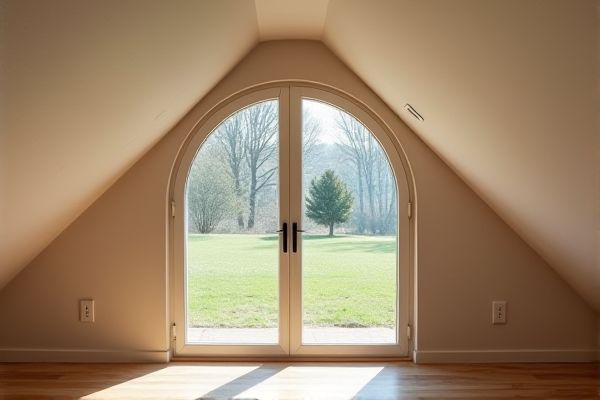
Attic sliding windows offer easy horizontal opening and take up less interior space, making them ideal for tight attic areas, while casement windows provide superior ventilation and a tight seal by swinging outward on hinges. Discover which window type best suits your attic's needs by exploring the detailed comparisons in the rest of the article.
Table of Comparison
| Feature | Attic Sliding Window | Casement Window |
|---|---|---|
| Design | Horizontal sliding sash, ideal for limited space. | Side-hinged, opens outward like a door. |
| Ventilation | Partial ventilation, sliding opens half the window. | Excellent ventilation, can open fully for maximum airflow. |
| Installation Location | Best for attic or low-ceiling spaces. | Suitable for various rooms, commonly in living areas. |
| Energy Efficiency | Moderate, depends on seal quality. | High, tight seals reduce air leakage. |
| Maintenance | Easy to clean and operate. | Requires regular hinge lubrication and seal checks. |
| Security | Sliding locks available but easier to force open. | More secure with multi-point locking systems. |
| Cost | Generally lower price range. | Typically more expensive due to hardware. |
Overview of Attic Sliding Windows and Casement Windows
Attic sliding windows feature horizontal sashes that slide open, providing easy ventilation and space-saving operation ideal for confined attic spaces. Casement windows, hinged at the side, swing outward like a door, offering superior airflow and unobstructed views. Both window types vary in installation suitability, energy efficiency, and maintenance requirements, making choice dependent on attic design and ventilation needs.
Design Differences: Sliding vs Casement Windows
Sliding windows operate on a horizontal track, allowing the sash to glide smoothly side-to-side, making them ideal for attic spaces with limited headroom. Casement windows hinge at the side and swing outward, offering superior ventilation and unobstructed views but requiring more clearance to open fully. Understanding these design differences helps you choose the optimal attic window type that balances functionality, space constraints, and aesthetic appeal.
Energy Efficiency Comparison
Attic sliding windows often provide moderate energy efficiency due to their simpler design and potential for air leakage, whereas casement windows excel in sealing tight when closed, significantly reducing drafts and heat loss. Casement windows use compressive seals that improve insulation performance, making them more effective in minimizing energy consumption for heating and cooling. The airtight construction of casement windows typically results in better thermal performance compared to the larger gaps inherent in sliding window mechanisms.
Ventilation and Airflow Capabilities
Attic sliding windows provide adjustable ventilation by allowing horizontal movement, enabling partial or full opening for customizable airflow, which is ideal for tight spaces. Casement windows, hinged on one side, offer superior airflow as they can be fully opened outward, capturing breezes more efficiently and directing fresh air into the attic. For maximum attic ventilation, casement windows generally outperform sliding windows due to their ability to catch and funnel air effectively.
Space and Installation Requirements
Attic sliding windows require less space inside the room since they open horizontally along the track, making them ideal for tight or narrow attic areas. Casement windows need clear exterior space to swing outward on hinges, which can be challenging in confined or obstructed attic locations. Your choice should consider the available installation space and ease of access to ensure proper functionality and ventilation.
Maintenance and Durability
Attic sliding windows require regular track cleaning and lubrication to ensure smooth operation, while casement windows demand periodic hinge inspections and weatherstripping replacement to maintain airtight seals. Sliding windows often have fewer mechanical parts exposed to weather, enhancing durability in dusty environments, whereas casement windows offer robust frames that resist warping and provide superior protection against drafts and water intrusion. Both window types benefit from quality materials like aluminum or vinyl, but casement windows generally offer longer lifespan with proper maintenance due to their solid construction and tighter closure mechanisms.
Safety and Security Features
Attic sliding windows feature secure locking mechanisms that minimize the risk of break-ins while offering easy egress in emergencies. Casement windows provide enhanced safety with multi-point locks that tightly seal the window frame, deterring forced entry and improving overall home security. Both window types can be fitted with tempered or laminated glass to increase resistance against impacts and enhance occupant protection.
Aesthetic Appeal in Attic Spaces
Attic sliding windows offer a sleek, minimalist aesthetic that enhances modern and contemporary attic spaces by maintaining unobstructed views and clean lines. Casement windows provide a classic charm with their hinged design, allowing for decorative hardware and deeper window sills that add architectural interest. Both window types can complement attic interiors, but sliding windows excel in maximizing natural light without interrupting the visual flow.
Cost Considerations and Value
Attic sliding windows generally offer a more budget-friendly option compared to casement windows due to simpler installation and fewer moving parts, which reduces maintenance costs over time. Casement windows provide higher energy efficiency and better ventilation, potentially increasing your home's value despite their higher initial price. Evaluating your budget alongside long-term benefits helps determine the best investment for your attic upgrade.
Choosing the Right Window for Your Attic
Attic sliding windows offer streamlined ventilation and space-saving design, ideal for tight or limited areas where outward swinging is impractical. Casement windows provide superior airflow and unobstructed views through side hinges that open fully, making them a favored choice for maximizing natural light and ventilation. Your decision hinges on attic space constraints and ventilation needs, balancing functionality with aesthetic appeal for optimal comfort and efficiency.
 homyna.com
homyna.com